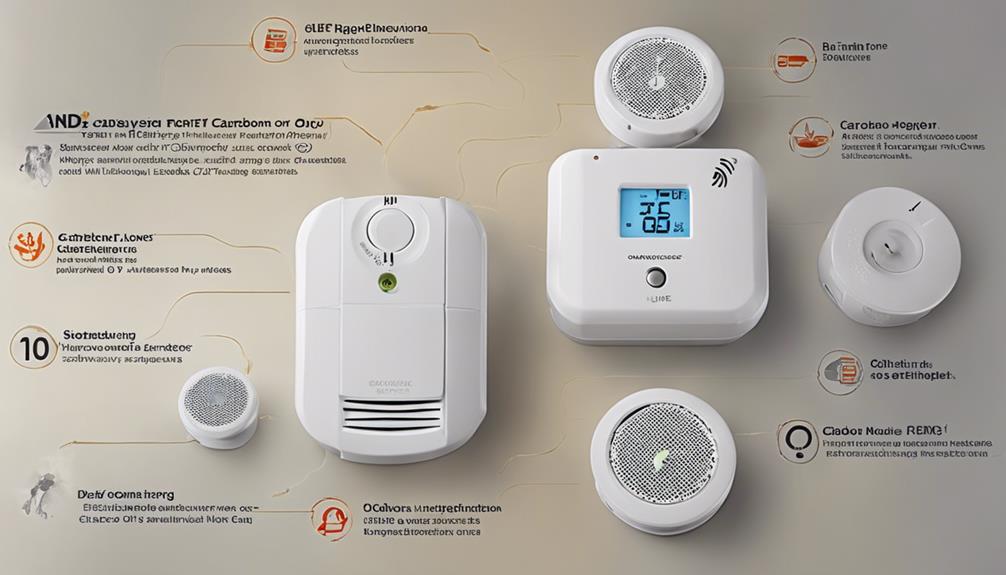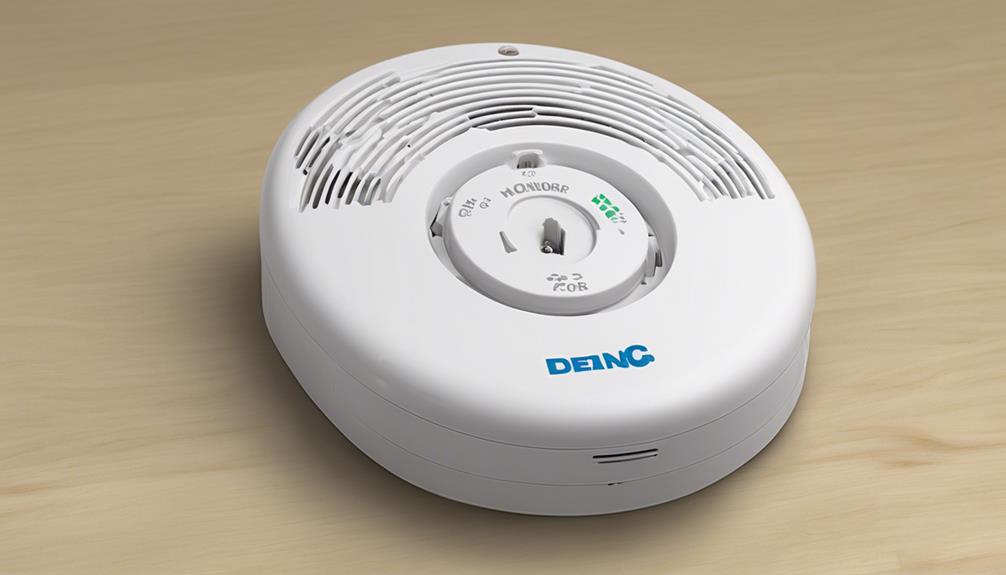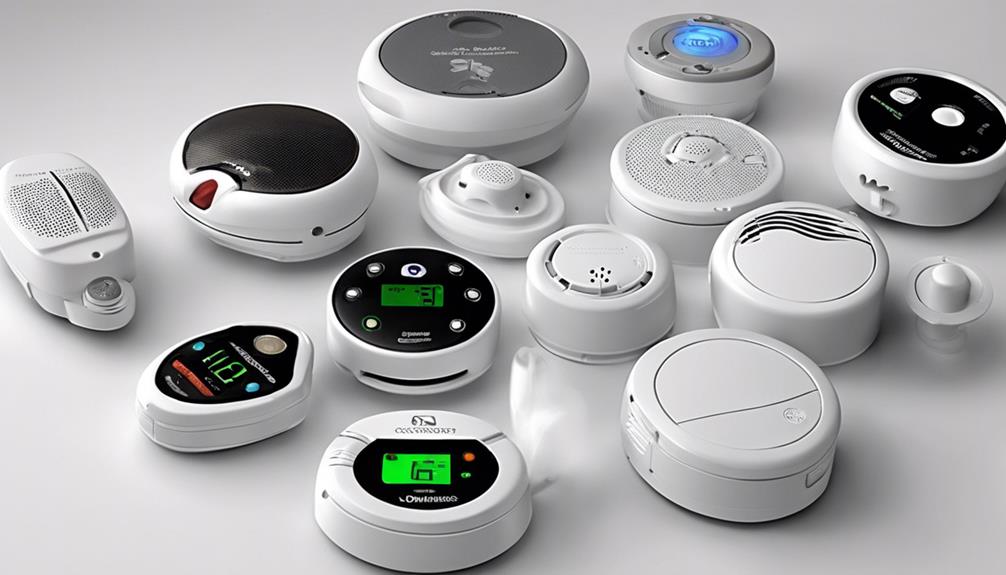When selecting a carbon monoxide detector for individuals who are deaf, it is important to focus on features specifically designed for those with hearing impairments. Visual alerts such as LED strobe lights and vibration alerts are crucial for prompt emergency response.
Ensuring battery backup reliability, dual protection, and adherence to ADA and UL standards are vital. But, what about compatibility with assistive devices and types of detectors?
Let's explore how these factors influence the effectiveness of carbon monoxide detection for individuals with hearing challenges, enhancing home safety measures.
Key Takeaways
- Use detectors with high-intensity strobe lights for visual alerts.
- Opt for models with customizable vibration alerts.
- Ensure compatibility with smartphones and smartwatches.
- Choose detectors meeting ADA and UL standards for reliability.
Importance of Visual Alerts
Visual alerts play a crucial role in ensuring the safety of deaf individuals by providing immediate notification in the presence of carbon monoxide. When it comes to carbon monoxide detectors, high-intensity strobe lights are indispensable for alerting individuals who are deaf to the presence of CO. These visual alerts are designed to be attention-grabbing and easily noticeable, ensuring that deaf individuals can respond promptly to dangerous levels of carbon monoxide in their environment. By incorporating visual indicators into carbon monoxide detectors, the overall safety for the deaf community is significantly enhanced.
Choosing a carbon monoxide detector with visual alerts isn't just a matter of preference but a vital safety consideration for individuals who are deaf. These visual alerts act as a lifeline, providing essential information when CO levels rise to dangerous levels. The integration of strobe lights in carbon monoxide detectors ensures that deaf individuals aren't left unaware in the event of a CO leak, ultimately contributing to a safer living environment for all.
Consideration of Vibration Features

When choosing a carbon monoxide detector for the deaf, it's crucial to consider the vibration features.
These features provide tactile alerts that can effectively notify individuals with hearing impairments.
Opt for detectors with adjustable vibration intensity to ensure personalized and reliable alerts.
Vibration for Alerts
To ensure effective alert notifications for deaf individuals, the inclusion of vibration features in carbon monoxide detectors is crucial for providing tactile responses to warn of dangerous carbon monoxide levels.
Vibration alerts offer a tactile response, allowing deaf individuals to feel the alert notification. Some detectors even provide customizable vibration patterns for different alerts, enhancing user experience and customization.
By incorporating vibration alerts, carbon monoxide detectors help bridge the communication gap within the deaf community, ensuring everyone is alerted promptly to dangerous levels of carbon monoxide.
This innovative feature not only enhances safety but also demonstrates a commitment to inclusivity by catering to the specific needs of deaf individuals.
Sensitivity to Movement
Considering the importance of vibration features in carbon monoxide detectors for alerting deaf individuals, the sensitivity to movement plays a crucial role in ensuring timely and effective notifications of dangerous CO levels.
Vibration alerts provide tactile feedback, crucial for the deaf community's safety. Adjustable sensitivity levels in detectors cater to individual needs, enhancing the user experience.
The movement sensitivity feature ensures that deaf individuals are promptly alerted to CO threats, offering peace of mind and a sense of security. By incorporating these advanced vibration capabilities, carbon monoxide detectors not only meet the needs of the deaf community but also provide an innovative solution to address safety concerns effectively.
The integration of movement sensitivity in detectors represents a significant step forward in ensuring the well-being of deaf individuals in the face of potential CO dangers.
Compatibility With Assistive Devices
Our priority in selecting a carbon monoxide detector for the deaf is to ensure compatibility with assistive devices such as strobe lights and vibrating alarms. To achieve this, consider the following:
- Interconnectivity: Look for carbon monoxide detectors that can be interconnected with alerting systems designed for the deaf and hard of hearing. This feature ensures that the alarm triggers all connected devices simultaneously, providing multiple notification points.
- Multiple Alert Options: Opt for devices that offer various alert options including visual (such as strobe lights), audible, and vibration alerts. Having multiple alert mechanisms ensures that individuals with hearing impairments don't miss important notifications.
- Wireless Transmitters: Check for detectors that offer options for wireless transmitters. These transmitters can send immediate notifications to compatible devices like smartphones or smartwatches, providing real-time alerts even when individuals aren't at home.
- Compliance with Standards: Prioritize detectors that meet ADA requirements and UL standards. Ensuring compliance with these standards guarantees reliable and effective use of the carbon monoxide detector with assistive devices, offering peace of mind and safety to the deaf community.
Types of Carbon Monoxide Detectors

When selecting a carbon monoxide detector, it's essential to understand the different types available and their specific features for optimal protection against this silent threat.
Carbon monoxide detectors come in various forms, each designed to cater to specific needs. Photoelectric sensors are effective in detecting slow smoldering fires, providing early warnings. On the other hand, detectors with electrochemical sensors are highly sensitive to carbon monoxide gas, effectively detecting low levels of CO.
For those looking for dual protection, combination carbon monoxide detectors can sense both smoke and carbon monoxide, offering comprehensive coverage. Some advanced models feature sealed lithium batteries with long lifespans for uninterrupted protection.
Wireless carbon monoxide detectors provide flexibility in placement and easy integration into existing home security systems, making them a convenient choice for many users.
Understanding the different types of carbon monoxide detectors ensures that individuals, including the deaf or hearing impaired, can select the most suitable option for their safety needs.
Factors Impacting Detection Efficiency

To ensure optimal carbon monoxide detection efficiency, the sensitivity of the detector plays a crucial role in detecting low levels of CO gas effectively. Factors impacting detection efficiency include:
- CO Detector Sensitivity: The ability of the detector to sense even minimal levels of carbon monoxide is essential for early detection and warning.
- Placement: Positioning the detector in key areas such as bedrooms and hallways increases the likelihood of detecting CO gas in a timely manner.
- Interconnectivity: Connecting the CO detector to other alarms in the house ensures a comprehensive warning system, alerting individuals throughout the home simultaneously.
- Maintenance: Regular maintenance and testing are vital to guarantee the detector functions correctly, providing reliable protection against carbon monoxide exposure.
Installation and Maintenance Tips

For optimal functionality and safety, it's crucial to adhere to specific installation and maintenance tips when setting up your carbon monoxide detector. Regularly testing your carbon monoxide detector using the test button ensures it's functioning properly.
Place detectors in multiple areas of your home, especially near sleeping areas, for comprehensive coverage. When installing, position the carbon monoxide detectors at least 15 feet away from fuel-burning appliances to accurately detect any leaks.
Opt for a hard-wired carbon monoxide alarm with visual alerts like strobe lights for those who are deaf or hard of hearing, providing clear and immediate notification in case of danger. Follow the manufacturer's instructions meticulously for both installation and maintenance to guarantee the effectiveness of your carbon monoxide detector.
Comparison of Top Brands and Models

Ensuring optimal functionality and safety in carbon monoxide detection, we'll now explore a comparison of the top brands and models available in the market.
- The BRK Electronics 7030BSL combines a dual smoke and carbon monoxide alarm with a photoelectric smoke sensing chamber and a powerful 177 LED candela strobe light for enhanced visual alerts for the hearing impaired.
- Kidde's CO5120BN stands out with its Intelligent Sensing Technology™, ensuring accurate carbon monoxide detection, and a reliable battery backup system.
- BRK's 7020BSL model features a photoelectric smoke sensing chamber, a bright 177 LED candela strobe light, and a sealed 3V lithium battery for extended durability.
- For those seeking a hard-wired smoke alarm, the BRK 9120B offers a dual ionization smoke sensing chamber, an 85dB alarm, and an audible battery backup feature for added safety.
These top brands and models provide a variety of features such as visual alerts, intelligent sensing technology, and battery backup, catering to the needs of the hearing impaired and ensuring efficient carbon monoxide detection.
Frequently Asked Questions
How Do I Choose a Carbon Monoxide Detector?
When choosing a carbon monoxide detector, we prioritize safety by looking for features like LED strobe lights for visual alerts. It's crucial to opt for detectors with both audible alarms and visual indicators for comprehensive safety.
We also consider models designed specifically for the hearing impaired and those offering multiple alert options such as vibration and flashing lights.
Ensuring the detector meets ADA requirements and UL standards is essential for effective carbon monoxide detection.
Can You Hear a Carbon Monoxide Detector if You Have Hearing Loss?
Yes, even with hearing loss, one can be alerted to carbon monoxide with specialized detectors. These devices employ high-intensity strobe lights and vibration alerts to ensure individuals are notified effectively.
Advanced models may offer customizable alerts to accommodate various types of hearing impairments. It's essential to select a CO detector that meets ADA requirements and provides reliable visual and tactile alerts for the safety of those with hearing loss.
What Type of Carbon Monoxide Detector Do I Need?
We need a carbon monoxide detector that's effective and reliable in alerting us to potential threats. Ensuring it meets ADA requirements, UL standards, and offers wireless integration is key.
Look for high-intensity strobe lights and clear alerts for maximum safety. Prioritize models with visual and vibrating notifications for deaf individuals.
Opt for seamless integration into existing alert systems for added convenience. It's essential to choose a detector that guarantees proper detection and notification.
How Does a Deaf Person Know if There Is a Fire or Carbon Monoxide?
We can't rely on sound alarms, but visual and tactile alerts like strobe lights, vibrating alarms, and bed shakers are crucial for our safety.
Dual alert systems, merging visual and audible alarms, are exceptional for added security.
Specialized carbon monoxide detectors equipped with vibration alerts ensure we receive immediate notifications during emergencies.
Interconnected systems with visual and tactile alerts guarantee prompt warnings about fire or carbon monoxide dangers, enhancing our safety.
Can the Carbon Monoxide Detector for the Deaf also be used as a fire alarm for deaf people?
Yes, the best fire alarms for deaf people can detect both carbon monoxide and fire. These specialized alarms use strobe lights and vibrating pads to alert individuals who are deaf or hard of hearing in the event of an emergency. It’s important to have multiple alarms throughout the home for safety.
Conclusion
In conclusion, choosing a carbon monoxide detector for the deaf is crucial for ensuring their safety at home.
Remember, the irony is that while these detectors are designed for the deaf, they actually provide visual and vibration alerts that can benefit all individuals in emergency situations.
So, whether you have a hearing impairment or not, investing in a reliable carbon monoxide detector with these features is a smart choice for everyone's safety.











